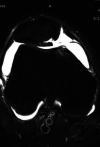Noniatrogenic Medial Patellar Dislocations: Case Series and International Patellofemoral Study Group Experience
- PMID: 33748301
- PMCID: PMC7938389
- DOI: 10.1177/2325967120985530
Noniatrogenic Medial Patellar Dislocations: Case Series and International Patellofemoral Study Group Experience
Abstract
Background: Most patellar dislocations occur in a lateral direction because of a summed lateral force vector and predisposing anatomic risk factors. Medial patellar instability is rare and is a well-recognized iatrogenic complication of an overly aggressive lateral retinacular release. Noniatrogenic medial patellar dislocations are rare. The management of these injuries is not well described.
Purpose: To describe the experience of the International Patellofemoral Study Group with patients with noniatrogenic medial patellar dislocation.
Study design: Case series; Level of evidence, 4.
Methods: Members of the International Patellofemoral Study Group (N = 64) were surveyed between October 2018 and April 2019. This group was chosen because of its wide referral base and interest in patellar instability. Specialists who had encountered a patient with medial patellar instability were sent a questionnaire inquiring about details of the case, including patient demographics, medical history, level of athletic competition, injury characteristics, and treatment. Cases were confirmed by physical examination records and, in some cases, with findings on advanced radiographic imaging.
Results: The survey response rate was 73% (47/64). Three of the 47 specialists (6.4%) reported they had seen a case of noniatrogenic medial patellar dislocation, for a total of 6 cases. Four cases were described as recurrent medial dislocations in the setting of hypermobile Ehlers-Danlos syndrome; 2 were treated nonoperatively, 1 underwent lateral patellofemoral ligament reconstruction, and 1 underwent derotational osteotomies. Two medial-sided patellar dislocations in collegiate athletes were sports-related injuries that required surgical debridement but no ligamentous reconstruction. None of the patients had persistent or recurrent instability at the time of their most recent follow-up.
Conclusion: Noniatrogenic medial patellar dislocations are extremely rare. This case review suggests that the treatment of first-time medial patellar instability in patients without known risk factors should follow the same principles as the treatment of lateral instability with no known risk factors, which is nonoperative management. For patients with documented risk factors and recurrence, surgery to address the risk factors may be appropriate.
Keywords: collegiate athlete; lateral patellar dislocation; medial patellar dislocation; noniatrogenic.
© The Author(s) 2021.
Conflict of interest statement
One or more of the authors has declared the following potential conflict of interest or source of funding: A.E.L. has received hospitality payments from Zimmer Biomet. J.F. has received research support from Active Implants, Arthrex, Episurf, Fidia Pharma, JRF Ortho, Moximed, Novartis, Organogenesis, Samumed, Vericel, and Zimmer Biomet; consulting fees from Aastrom Biosciences, Aesculap/B.Braun, Arthrex, Cartiheal, Ceterix, Cook Biotech, DePuy Synthes, Exactech, ISTO Technologies, MedShape, Moximed, Organogenesis, Osiris, Regentis, RTI Surgical, Samumed, Vericel, Zimmer Biomet, and ZKR Orthopedics; speaking fees from Aastrom Biosciences, Arthrex, Moximed, Organogenesis, Vericel, and Zimmer Biomet; and royalties from Arthrex, Biopoly, DePuy Synthes, Organogenesis, Springer, and Thieme Medical Publishers and has stock/stock options in MedShape and Ortho Regenerative Tech. S.N.P. has received education payments from CDC Medical and speaking fees from Synthes. AOSSM checks author disclosures against the Open Payments Database (OPD). AOSSM has not conducted an independent investigation on the OPD and disclaims any liability or responsibility relating thereto.
Figures




Similar articles
-
Medial patellofemoral ligament repair for recurrent patellar dislocation.Am J Sports Med. 2010 Nov;38(11):2248-54. doi: 10.1177/0363546510376230. Epub 2010 Aug 17. Am J Sports Med. 2010. PMID: 20716682
-
Factors Affecting the Outcomes of Double-Bundle Medial Patellofemoral Ligament Reconstruction for Recurrent Patellar Dislocations Evaluated by Multivariate Analysis.Am J Sports Med. 2015 Dec;43(12):2988-96. doi: 10.1177/0363546515606102. Epub 2015 Oct 4. Am J Sports Med. 2015. PMID: 26435448
-
Clinical Outcomes After Isolated Medial Patellofemoral Ligament Reconstruction for Patellar Instability Among Patients With Trochlear Dysplasia.Am J Sports Med. 2018 Mar;46(4):883-889. doi: 10.1177/0363546517745625. Epub 2018 Jan 3. Am J Sports Med. 2018. PMID: 29298083
-
Current concepts of lateral patella dislocation.Clin Sports Med. 2002 Jul;21(3):499-519. doi: 10.1016/s0278-5919(02)00031-5. Clin Sports Med. 2002. PMID: 12365240 Review.
-
Guidelines for medial patellofemoral ligament reconstruction in chronic lateral patellar instability.J Am Acad Orthop Surg. 2014 Mar;22(3):175-82. doi: 10.5435/JAAOS-22-03-175. J Am Acad Orthop Surg. 2014. PMID: 24603827 Review.
Cited by
-
Patellar Tracking: An Old Problem with New Insights.Radiographics. 2023 Jun;43(6):e220177. doi: 10.1148/rg.220177. Radiographics. 2023. PMID: 37261964 Free PMC article.
References
-
- Ahmad CS, Sinicropi SM, Su B, Puffinbarger WR. Congenital medial dislocation of the patella. Orthopedics. 2003;26(2):189–190. - PubMed
-
- Fulkerson JP. A clinical test for medial patella tracking (medial subluxation). Tech Orthop. 1997;12:144.
-
- Gravesen KS, Kallemose T, Blond L, Troelsen A, Barfod KW. High incidence of acute and recurrent patellar dislocations: a retrospective nationwide epidemiological study involving 24.154 primary dislocations. Knee Surg Sports Traumatol Arthrosc. 2018;26(4):1204–1209. - PubMed
-
- Hevesi M, Heidenreich MJ, Camp CL, et al. The recurrent instability of the patella score: a statistically based model for prediction of long-term recurrence risk after first-time dislocation. Arthroscopy. 2019;35(2):537–543. - PubMed
LinkOut - more resources
Full Text Sources
Other Literature Sources
Miscellaneous

